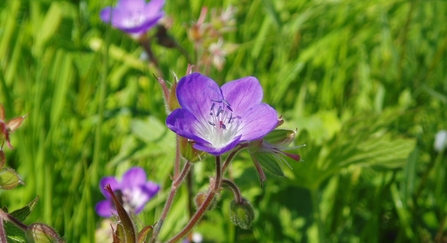
Wood crane's bill © Kelly Muldoon

Wood crane's bill © Kelly Muldoon
Cumbria Wildlife Trust is seeking to recruit the help of nature-friendly farmers and landowners in the south of the county to boost the declining number of grassland wildflowers and plants in Cumbria. We aim to re-introduce rarer species to suitable sites, particularly in the Windermere and Ambleside areas.
In a two-year project, up to 40,000 plants will be grown at our nursery at Gosling Sike near Carlisle. Working alongside landowners, we'll then add a variety of these plug plants to South Lakeland sites and help the landowners provide the best conditions for them to prosper.
The scheme will provide participating farmers and other landowners with botanical surveys, soil testing, plug plants, and a management plan, all free of charge.* Farmers, foresters and land managers can use these to help them look after and improve the environment. They can also be used to support and inform applications for Countryside Stewardship (CS) schemes and Sustainable Farming Incentive (SFI) schemes.
Tanya St. Pierre, Grassland and Pollinator Team Manager for Cumbria Wildlife Trust said:
“We’re really looking forward to working with local farmers and other landowners to get this scheme underway. Here in Cumbria, we’re lucky to have a treasure trove of truly beautiful and evocative wild flowers. But sadly, they’re vanishing rapidly from our countryside at an alarming pace. We’re calling on landowners, tenants and farmers, to help us re-establish some of our most rare and vulnerable wild plants back in to the Cumbrian landscape, so that they’re not lost forever.
“Focusing on meadow species, we’ll work with landowners to identify suitable sites such as existing hay meadows and County Wildlife Sites, where we can re-introduce or bolster populations of a range of species including wood crane’s-bill, globeflower, melancholy thistle, wood bitter vetch, dyer’s greenweed, and betony. I urge anyone who wants to get involved with this exciting project to get in touch with me as soon as possible!”
IMPORTANT UPDATE 19/12/2024: We've been inundated with requests from farmers who would like to get involved with this project, which is brilliant. Thank you to everyone who has been in touch, and I'm afraid we can't take on any more applications.
* Services will be available to landowners and farmers at no cost, on provision that a five-year landowner agreement is in place. The agreement will support species-rich grassland and hay making options of SFI and CS agreements, however you do not need to be in a stewardship agreement to be eligible.
Funded by National Lottery Heritage Fund and delivered by Cumbria Wildlife Trust, Cumbria Seed Bank is a two-year project that aims to reverse the decline of rare and iconic wild flowers of grassland habitats in Cumbria. Survey, conservation and restoration works are due to take place in summer 2025 and 2026.
About The National Lottery Heritage Fund
Our vision is for heritage to be valued, cared for and sustained for everyone, now and in the future. That’s why as the largest funder for the UK’s heritage we are dedicated to supporting projects that connect people and communities to heritage, as set out in our strategic plan, Heritage 2033. Heritage can be anything from the past that people value and want to pass on to future generations. We believe in the power of heritage to ignite the imagination, offer joy and inspiration, and to build pride in place and connection to the past.
Over the next 10 years, we aim to invest £3.6billion raised for good causes by National Lottery players to make a decisive difference for people, places and communities.
Follow @HeritageFundUK on Twitter/X, Facebook and Instagram and use #NationalLottery #HeritageFund